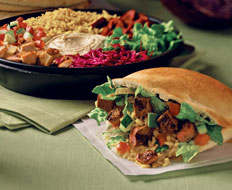The health benefits of a Mediterranean diet have been getting a lot of attention in recent years, and quick-serve restaurants have also been a “big thing,” says Alon Mor, founder of Garbanzo Mediterranean Grill. And the economy … well, two out of three isn’t bad.
“We’ve never operated in good days,” Mor says. “Even the low days were heydays for us. We’ve been very successful in a bad economy so we can’t wait for the recovery.”
Mor, who was born in Israel and educated in the U.S., learned the ropes of the quick-serve industry at Panera Bread, where he worked as a district manager and observed the competition.
“I saw Chinese and Mexican concepts booming in the fast-casual segment, but no one was doing Mediterranean,” he says.
In 2007, armed with recipes from the kitchens of his mother and grandmother, he founded Garbanzo with the goal of bringing Americans the foods and spices that reminded him of the Mediterranean Sea in a safe, clean, fast-casual environment.
The first Garbanzo store opened in 2008 and the concept has since grown to 13 locations in the Denver and Colorado Springs areas. More growth is expected this year as Garbanzo is poised to start franchising. By the end of 2012, Mor says, the Garbanzo chain should be 50 restaurants strong, with corporate and franchise locations in Colorado and undisclosed Midwest and East Coast markets.
A typical Garbanzo restaurant is located in a strip mall. It is about 2,200 square feet with seating for 75–95 guests. Open seven days a week from 11 a.m. until 9 p.m. or 10 p.m., each Garbanzo location makes its own pita bread, salads, sauces, hummus, falafel, and just about everything else on the menu from scratch using fresh ingredients.
The menuboard guides each Garbanzo customer through a three-step ordering process. First, customers choose to have their meal in either a whole-wheat pita, on a plate with a pita on the side, inside a wrap called a Laffa, or on top of Garbanzo Greens—a salad that combines romaine lettuce with garbanzo beans, feta cheese, and red onions and is served with a side of pita bread.
Next, customers choose what they want inside the pita or Laffa or served atop the plate or salad. These additions include chicken or steak shawarma, which is lean meat marinated with spices, or a combination of the two called falarma. Falafel and hummus are available as vegetarian options.
Garbanzo Mediterranean Grill
CEO & Founder: Alon Mor
HQ: Centennial, Colorado
Year Started: 2007
Annual Sales: Undisclosed
Total Units: 13
Franchise units: 0
Step three—“The Top”—offers choices of salads, salad dressings, sauces, and extras including a hard-boiled egg, grilled eggplant, and feta. Soups like Lemon Chicken & Orzo and Roasted Eggplant round out the menu.
The average ticket at a Garbanzo is $9 with a drink. Drink selections include three signature iced teas sweetened with stevia, a natural sweetener, rather than sugar. The beverages help further the mission of Garbanzo to help customers realize they can get healthy food and great taste at the same time.
“Our biggest challenge is education,” Mor says. “In front of every store we have a store employee dressed as a garbanzo bean and we sample falafel all the time. Every single customer is greeted with a falafel. It keeps them busy while they are in line.”
He says the job of educating customers is getting easier as the years go by.
“Five years ago people didn’t even know what you were talking about when you mentioned hummus, but now you can buy it at any local grocery store,” Mor says.
While the falafel—ground garbanzo beans mixed with fresh herbs and spices in a crispy ball—is fried, Mor says it is flash fried and doesn’t absorb too much oil, so it weighs in at only 25 calories per ball. The rest of the menu is based on greens and is therefore very healthy.
Information on the Garbanzo website explains that the shared features of what is called a Mediterranean-style diet include a high consumption of fruits, vegetables, bread and other cereals, beans, nuts, and seeds, with dairy products, fish, and poultry consumed in low to moderate amounts. Olive oil is also widely used.
Word has been spreading about the healthy menu at Garbanzo through social networking sites like Facebook. While that’s not unusual in the restaurant business these days, Mor says what has surprised him is how much the chain’s fans are willing to share, including before and after pictures of themselves as they’ve lost weight in part because of healthy meals from Garbanzo.
“Since our concept is so healthy and fresh, we hooked up with a nutritionist who came up with tips and menu ideas to help people become more healthy,” Mor says.
Those tips and ideas are called the “M-M-M Diet,” which stands for Mediterranean Middle Meltdown. Point-of-purchase advertising at the store level is based on M-M-M, and there’s a whole page devoted to it on the Garbanzo Facebook site.
“We really want to help our customers eat great food that’s healthy,” Mor says.
“And we try to keep it interesting by occasionally adding new sauces and constantly rotating our soups. It’s hard to convey taste on billboards—the word of mouth has been great for us.”









